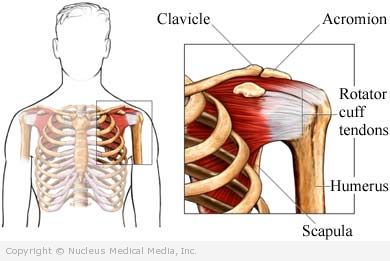Shoulder tendinopathy
(Shoulder Tendonitis; Shoulder Tendinosis; Bicipital Tendinopathy; Bicipital Tendonitis; Bicipital Tendinosis; Supraspinatus Tendinopathy; Supraspinatus Tendonitis; Supraspinatus Tendinosis; Pitcher’s Shoulder; Swimmer’s Shoulder; Tennis Shoulder)
Shoulder tendinopathy – Definition
Tendinopathy is an injury to the tendon. It can cause pain, swelling, and limit movement. The injuries can include:
- Tendonitis — an inflammation of the tendon. (Although this term is used often, most cases of tendinopathy are not associated with significant inflammation.)
- Tendinosis — microtears (tiny breaks) in the tendon tissue with no significant inflammation.
There are several shoulder tendons including the rotator cuff and biceps tendons. These tendons keep the head of the humerus (the upper arm bone) in the shoulder socket. Tendinopathy and the associated pain may take months to resolve.
Shoulder tendinopathy – Causes
Tendinopathy is generally caused by overuse of a muscle-tendon unit. Over time, the strain on the tendon causes structural changes within the tendon itself.
Shoulder tendons are overused most often with:
- Repeated reaching overhead
- Repeated throwing
- Bicipital tendinopathy is linked to rotator cuff conditions. Rotator cuff tendinopathy may result from wear and tear with age.
Shoulder tendinopathy – Risk Factors
Factors that increase your chance of developing shoulder tendinopathy include:
- Age: 30 and over
- Always using the arm in an overhead position or throwing motion, as in:
- Tennis or other racquet sports
- Swimming
- Baseball
- Jobs (eg, overhead assembly work, butchering, or using an overhead pressing machine)
Shoulder tendinopathy – Symptoms
Symptoms develop gradually over time and pain slowly increases with use.
If you have any of these symptoms do not assume it is due to shoulder tendinopathy. These symptoms may be caused by other conditions. Tell your doctor if you have any of these:
- Pain (a dull ache) in the shoulder and upper arm
- Pain at night, especially when sleeping on the injured side
- Pain when trying to reach for a back zipper or pocket
- Pain with overhead use of the arm
- Shoulder weakness, usually due to pain with effort
- Shoulder stiffness with some loss of motion
Shoulder tendinopathy – Diagnosis
The doctor will ask about your symptoms and medical history. A physical exam will be done. Your doctor will check tender areas, range of motion, and muscle strength.
For severe symptoms or to rule out other problems your doctor may order:
- X-rays — a test that uses radiation to take a picture of structures inside the body
- MRI scan — a test that uses magnetic waves to make pictures of the inside of the body,
- CT arthrography — a type of x-ray that uses a computer to make pictures of the joint after a dye has been injected into the joint
- Local anesthetic injection into the bursa overlying the rotator cuff tendons
- This may confirm diagnosis if pain is relieved.
- Arthroscopy — Done under anesthesia, a long, thin, fiberoptic tube with a light on the end is inserted through a small incision in the shoulder to look at the structures inside
- This is more likely done if your doctors thinks you have a rotator cuff rupture.
Shoulder tendinopathy – Treatment
Treatments include:
Rest
Avoid activities that cause shoulder pain.
Ice
To control pain and swelling:
- Use for 20 minutes at a time.
- Use during the first 24-48 hours after injury or after exercise.
- Protect your skin by placing a towel between the ice and your skin.
Heat
Heat may relieve pain and is often used before exercises to help with motion:
- Do not use with acute pain or following acute injury.
- Check with a doctor or therapist before using heat the first time.
- Use for 15-20 minutes at a time.
- Protect your skin by placing a towel between the heat source and your skin.
Medication
- Nonsteroidal anti-inflammatory drugs (NSAIDs) to manage pain (eg, aspirin or ibuprofen)
- Topical pain medicines (eg, cream, patches) that are applied to the skin
- Steroid injection into the bursa overlying the rotator cuff to decrease inflammation
- Injection of botulinum toxin
Rehabilitation
- Physical therapy to strengthen muscles that control the shoulder
- Exercises to maintain normal range of motion
- Exercises for specific muscles that are used in sports or job activities
- Gradual return to sports and work
- Learning how to modify activities to prevent re-injury
Surgery
Different procedures can be used depending on the injury:
- Arthroscopic surgery
- Open technique
Shoulder tendinopathy – Prevention
To protect the shoulder from injury:
- Do regular resistance exercises to strengthen the muscles.
- Use proper athletic training methods.
- Do not increase exercise duration or intensity more than 10% per week.
- Avoid overusing your arm in an overhead position.
- Change job requirements to avoid overhead activity.
- Do not ignore or try to work through shoulder pain.

